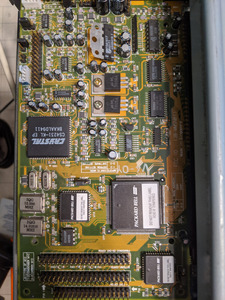dionb wrote on 2020-08-04, 06:27:How did you confirm that? […]
Show full quote
How did you confirm that?
Again, this card doesn't need drivers or initialization, and SET BLASTER doesn't set the card, it tells software that uses that variable where to find it, that's all. So just take software where you can specify IRQ and DMA yourself and try combinations one by one to discover current settings.
Concretly: take a game that lets you choose settings yourself (I tend to use Sid Meier's Colonization, but there are hundreds of other options), set address to 220, then try the other two sequentially:
I5 D1
I7 D1
I3 D1
I5 D0
I7 D0
I3 D0
I5 D3
I7 D3
I3 D3
If you guess wrong, at worst the system will hang because of IRQ/DMA conflict. No problem, just reboot and try the next one. One of these should work. Once you find it, alter SET BLASTER to that value and you should be good to go. Finding the DOS config tool would be a nice bonus, but not essential to operation.
I tried exactly what you you suggested with different IRQ and DMA settings. I did it with Return to Zork, which I had sitting nearby. Game would lock up every time. I did make some progress on what Packard Bell called these cards though. The Forte 16 SBPA. I removed the Sound16A drivers and folders that were installed with the Packard Bell Recovery CD, and installed the Forte 16 software. Here's something interesting. When I set the jumper to EEPROM, when trying to check the card, it says Sound Hardware not found. But if I set it to Software controlled, then I can get in and configure settings. So I set the soundcard settings for WSS 530H, IRQ 7, DMA 0 and Sound Blaster settings are 220H, IRQ 5, DMA 1. I can run the tests. FM works, 8 bit VOC test works, 16 bit sound test hangs. I don't have a midi device hooked up to test the midi in and midi out. Next interesting thing. Once the Forte 16 SBPA drivers were installed. In Windows I no longer get that horrendous tone that is generated from the CD-Audio volume on the Mixer. Sound works fine in Windows. I save all of the settings to EEPROM and update the AUTOEXEC.BAT. Shut the machine down, move the jumper back to EEPROM. Boot the machine, and it can't find the Sound Hardware. So I went to bed. This morning I get up and I put the jumper back on Software. Configured the card, again. Saved settings to EEPROM and updated the AUTOEXEC.BAT again, and rebooted the machine as it dictated. Configure sound settings in Return to Zork for Sound Blaster with 220H I5 D1 and Sound Blaster Pro for music, since I have heard this card has issues with running in Sound Blaster Pro mode with some software. Game boots, no error messages. But no digital sound, but the midi works! So progress there. Tried again with setting the sound card settings to Sound Blaster Pro and the game hangs.
It just seems extremely weird that when I set the card to run from the EEPROM that the card seems to just shut down. I am guessing that for whatever reason the updates to the configuration on the EEPROM aren't being updated when I finish making them, which results in the AUTOEXEC.BAT settings not lining up with the card resulting in it not working. I can hear the pop at boot up from the speakers, so I know the card is immediately grabbing the resources it demands like other Aztech cards but everything above is as far as I have gotten. So yay, progress! I will test some different games and make sure it's not an incompatibility with Return to Zork and relay more information when I have it.
